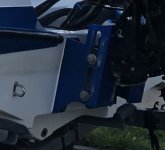RidinDirty
Member
85 starflite
10” cmc hydro jack plus spacer, total 10”
Looking to repower to a 250 pro xs Gen 2 wingmaster lower
Will my setback and setup work with a gen 2 lower unit?
Have read that the gen 2 needs exact setup to function properly
Currently runnin a 95 xri 200 at
5900 60mph.
Fastest iv seen 6100 64mph
Where do i measure set back correctly? At the back of the V hull to lower unit nose?
Anyone have experience with the gen 2 torque master? With “wings”
10” cmc hydro jack plus spacer, total 10”
Looking to repower to a 250 pro xs Gen 2 wingmaster lower
Will my setback and setup work with a gen 2 lower unit?
Have read that the gen 2 needs exact setup to function properly
Currently runnin a 95 xri 200 at
5900 60mph.
Fastest iv seen 6100 64mph
Where do i measure set back correctly? At the back of the V hull to lower unit nose?
Anyone have experience with the gen 2 torque master? With “wings”


